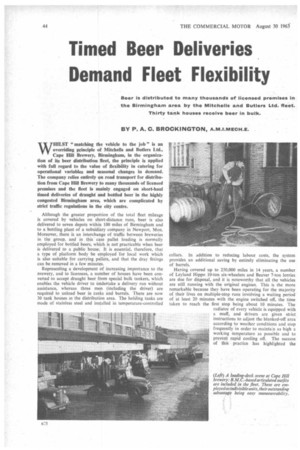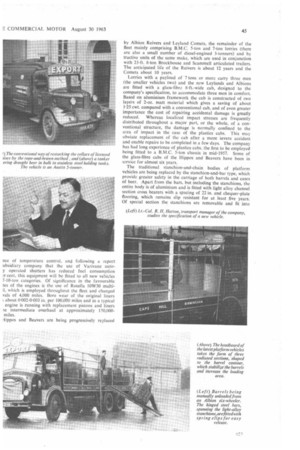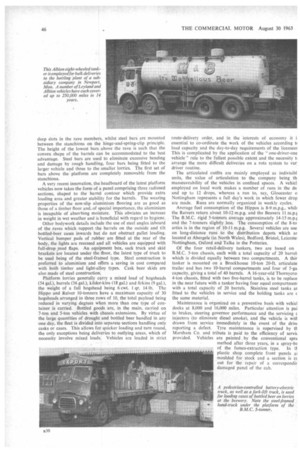Timed Beer Deliveries Demand Fleet Flexibility
Page 46

Page 47

Page 48

If you've noticed an error in this article please click here to report it so we can fix it.
Beer is distributed to many thousands of licensed premises in the Birmingham area by the MitchelIs and Butlers Ltd. fleet. Thirty tank houses receive beer in bulk.
BY P. A. C. BROCK1NGTON, A.M.I.MECH.E.
WHILST "mulching the %elide to the job" is an overriding principle of Mitchells and Butlers Ltd., Cape Hill Brewery, Birmingham, in the organization of its beer distribution fleet, the principle is applied with full regard to the value of flexibility in catering for operational variables and seasonal changes in demand. The company relies entirely on road transport for distribution from Cape Hill Brewery to many thousands of licensed premises and the fleet is mainly engaged on short-haul timed deliveries of draught and bottled beer in the highly congested Birmingham area, which are complicated by strict traffic regulations in the city centre.
Although the greater proportion of the total fleet mileage is covered by vehicles on short-distance runs, beer is also delivered to seven depots within 100 miles of Birmingham and to a bottling plant of a subsidiary company in Newport, Mon. Moreover, there is an interchange of traffic between breweries in the group, and in this case pallet loading is normally employed for bottled beers, which is not practicable when beer is delivered to a public house. It is essential, therefore, that a type of platform body be employed for local work which is also suitable for carrying pallets, and that the dray fittings can be removed in a few minutes.
Representing a development of increasing importance to the brewery, and to licensees, a number of houses have been converted to accept draught beer from special bulk tankers, which enables the vehicle driver to undertake a delivery run without assistance, whereas three men (including the driver) are required to unload beer in casks and barrels. There are now 30 tank houses in the distribution area. The holding tanks are made of stainless steel and installed in temperature-controlled cellars. In addition to reducing labour costs, the system provides an additional saving by entirely eliminating the use of barrels.
Having covered up to 250,000 miles in 14 years, a number of Leyland Hippo 10-ton six-wheelers and Beaver 7-ton lorries are due for disposal, and it is noteworthy that all the vehicles are still running with the original engines. This is the more remarkable because they have been operating for the majority of their lives on multiple-stop runs involving a waiting period of at least 20 minutes with the engine switched off, the time taken to reach the first stop being about 10 minutes. The radiator of every vehicle is equipped with a muff, and drivers are given strict instructions to adjust the blanked-off area according to weather conditions and stop frequently in order to mainta:n as high a working temperature as possible and to prevent rapid cooling off. The success of this practice has highlighted the nce of temperature control, and following a report ubsidiary company that the use of Varivane autoy operated shutters has reduced fuel consumption !.1cent, this equipment will be fitted to all new vehicles 7-10-ton categories. Of significance in the favourable tes of the engines is the use of Rotella 10W30 multiif, which is employed throughout the fleet and changed vats of 4,000 miles. Bore wear of the original liners ; about 0-002-0.003 in. per 100,000 miles and in a typical engine is running with replacement pistons and liners le intermediate overhaul at approximately 150,000miles.
iippos and Beavers are being progressively replaced by Albion Reivers and Leyland Comets, the remainder of the fleet mainly comprising B.M.C. 5-ton and 7-ton lorries (there are also a small number of diesel-engined 3-tonners) and by tractive units of the same make, which are used in conjunction with 23-ft. 8-ton Brockhouse and Scammell articulated trailers. The anticipated life of the Reivers is about 12 years and the Comets about 10 years.
Lorries with a payload of .7 tons or more carry three men (the smaller vehicles two) and the new Leylands and Albions are fitted with a glass-fibre 8-ft.-wide cab, designed to the company's specification, to accommodate three men in comfort. Based on aluminium framework the cab is constructed of two layers of 2-oz. matt material which gives a saving of about 1.25 cwt. compared with a conventional cab, and of even greater importance the cost of repairing accidental damage is greatly reduced. Whereas localized impact stresses are frequently distributed throughout a major part, or the whole, of a conventional structure, the damage is normally confined to the area of impact in the case of the plastics cabs. This may obviate replacement of the cab after a more severe accident and enable repairs to be completed in a few days. The company has had long experience of plastics cabs, the first to be employed being fitted to a B.M.C. 5-ton chassis in mid-1957. Some of the glass-fibre cabs of the Hippos and Beavers have been in service for almost six years.
The traditional stanchion-and-chain bodies of platform vehicles are being replaced by the stanchion-and-bar type, which provide greater safety in the carriage of both barrels and cases of beer. Apart from the bars, but including the stanchions, the entire body is of aluminium and is fitted with light alloy channel section cross bearers with a spacing of 22 in. and chequer-plate flooring, which remains slip resistant for at least five years. Of special section the stanchions are removable and fit into deep slots in the rave members, whilst steel bars are mounted between the stanchions on the hinge-and-spring-clip principle. The height of the lowest bars above the rave is such that the convex shape of the barrels can be accommodated to the best advantage. Steel bars are used to eliminate excessive bending and damage by rough handling, four bars being fitted to the larger vehicle and three to the smaller lorries. The first set of bars above the platform are completely removable from the stanchions.
A very recent innovation, the headboard of the latest platform vehicles now takes the form of a panel comprising three radiused sections, shaped to the barrel contour which provide extra loading area and greater stability for the barrels. The wearing properties of the non-slip aluminium flooring are as good as those of a timber floor and, of special importance, the aluminium is incapable of absorbing moisture. This obviates an increase in weight in wet weather and is beneficial with regard to hygiene.
Other bodywork details include the use of steel angles inboard of the raves which support the barrels on the outside and tilt bottled-beer cases inwards but do not obstruct pallet loading. Vertical bumper pads of rubber are fitted at the rear of the body, the lights are recessed and all vehicles are equipped with full-drop mud flaps. An equipment box, sack truck and skid brackets are located under the floor, the latest type of truck to be used being of the steel-framed type. Steel construction is preferred to aluminium and offers a saving in cost compared with both timber and light-alloy types. Cask beer skids are also made of steel construction.
Platform lorries generally carry a mixed load of hogsheads (54 gal.), barrels (36 gal.), kilder-kins (18 gal.) and firkins (9 gal.), the weight of a full hogshead being 6 cwt. 1 qr. 14 lb. The Hippo and Reiver 10-tonners have a maximum capacity of 30 hogsheads arranged in three rows of 10, the total payload being reduced in varying degrees when more than one type of container is carried. Bottled goods are, in the main, carried on 7-ton and 5-ton vehicles with chassis extensions. By virtue of the large quantities of draught and bottled beer handled in any one day, the fleet is divided into separate sections handling only casks or cases. This allows for quicker loading and turn round, the only exceptions being deliveries to outlying areas, which of necessity involve mixed loads. Vehicles are loaded in strict
route-delivery order, and in the interests of economy it i essential to co-ordihate the work of the vehicles according ti load capacity and the day-to-day requirements of the licensee: This is complicated by the application of the "one-driver-one vehicle" rule to the fullest possible extent and the necessity arrange the more difficult deliveries on a rota system to var, driver routine.
The articulated outfits are mainly employed as indivisibl units, the value of articulation to the company being th manoeuvrability of the vehicles in confined spaces. A vehicl employed on local work makes a number of runs in the da and up to 12 drops, whereas a run to, say, Gloucester o Nottingham represents a full day's work in which fewer drop are made. Runs are normally organized in weekly cycles.
Average fuel consumption of the Hippos is 8-9 m.p.g., whib. the Reivers return about 10-12 m.p.g. and the Beavers 11 tn.p.t The B.M.C. rigid 5-tormers average approximately 14-15 m.p4 and the 7-tonners slightly less. The consumption of the 8-to artics is in the region of 10-11 m.p.g. Several vehicles are use on long-distance runs to the distribution depots which ar located at Abergele (in North Wales), Bedford, Bristol, Leiceste Nottingham, Oxford and Talke in the Potteries.
Of the four retail-delivery tankers, two are based on B.M.C. 5-ton chassis, each with a total capacity of 20 barrel: which is divided equally between two compartments. A thir tanker is mounted on a Brockhouse 10-ton 20-ft. articulate trailer and has two 10-barrel compartments and four of 5-ga capacity, giving a total of 40 barrels. A 16-year-old Thornyera 4-ton chassis, fitted with two five-barrel tanks, is to be replace in the near future with a tanker having four equal cornpartmert with a total capacity of 20 barrels. Stainless steel tanks al fitted to the vehicles in service and the holding tanks are c the same material.
Maintenance is organized on a preventive basis with vehici docks at 8,000 and 16,000 miles. Particular attention is pai to brakes, steering governor performance and the servicing c injectors (to eliminate diesel smoke), and the vehicle is witl drawn from service immediately in the event of the drivi reporting a defect. Tyre maintenance is supervised by tt. Marsham Co. and tribute is paid to the efficiency of servic provided. Vehicles are painted by the conventional spra method after three years, in a spray-ba of the fumes-extraction type. In !I plastic shop complete front panels aJ moulded for stock and a section is ct out for the repair of a correspondir damaged panel of the cab.




































































































